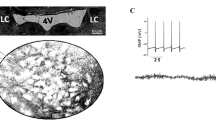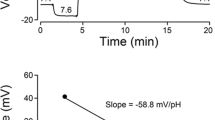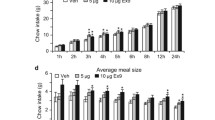Abstract
In previous studies we have reported that increases in food and water intake can be produced by microinjections of both NMDA selective and broad spectrum excitatory amino acid antagonists into the median raphe nucleus (MR). In the current experiments we examined the influence of kainate/quisqualate receptors in the MR on ingestive behavior. The consumption of food and water by deprived rats could be suppressed by intra-MR microinjections of the excitatory amino acid agonists kainic acid (5–10 ng in 0.5 µl vehicle) and quisqualic acid (125–500 ng). Conversely, intra-raphe injections of the kainate/quisqualate receptor antagonists pBB-PZDA (1.25–2.5 µg) and GAMS (10–20 µg) elicited feeding in nondeprived animals. pBB-PZDA was more potent in eliciting ingestive behavior than was the selective NMDA antagonist 2-amino-6-phosphonohexanoic acid, suggesting that the effects of pBB-PZDA were not mediated through the NMDA receptor. The current findings suggest that ingestive behaviors are tonically inhibited by excitatory amino acids acting at kainate/quisqualate receptors in the vicinity of the MR.
Similar content being viewed by others
References
Asin KE, Fibiger HC (1983) An analysis of neuronal elements within the median nucleus of the raphe that mediate lesion induced increases in locomotor behavior. Brain Res 268:211–223
Asin KE, Wirtshafter D, Kent EW (1979) Straight alley acquisition and extinction and open field activity following discrete electrolytic lesions of the mesencephalic raphe nuclei. Behav Neural Biol 25:242–256
Davies J, Jones AW, Sheardown MJ, Smith DAS, Watkins JC (1984) Phosphondipeptides and pterazine derivatives as antagonists of amino acid-induced and synaptic excitation in mammalian and amphibian spinal cord. Neurosci Lett 52:79–84
Jacobs BL, Wise WD, Taylor KM (1974) Differential behavioral and neurochemical effects following lesions of the dorsal or median raphe nuclei in rats. Brain Res 79:353–361
Kalen P, Pritzel M, Nieoullon A, Wiklund L (1986) Further evidence for excitatory amino acid transmission in the lateral habenular projection to the rostral raphe nuclei: lesion induced decrease of high affinity glutamate uptake. Neurosci Lett 68:35–40
Kirk RE (1968) Experimental design: Procedures for the behavioral sciences. Wadsworth, Belmont CA
Klitenick MA, Wirtshafter D (1988) Comparative studies of ingestive behavior following injections of muscimol into the midbrain raphe nuclei or the ventral tegmental area. Life Sci 42:775–782
Klitenick MA, Wirtshafter D (1989) Elicitation of feeding, drinking and gnawing following injections of muscimol into the median raphe nucleus of the rat. Behav Neural Biol 51:436–441
Klitenick MA, Wirtshafter D, Asin KE (1985) Studies of the hyperactivity produced by injections of muscimol or morphine into the median raphe nucleus. Soc Neurosci Abstr 11:720
Lorens SA (1978) Some biochemical effects of serotonin depletion depend on method: a comparison of 5,7-dihydroxytryptamine, p-chloroamphetamine and electrolytic raphe lesions. Ann NY Acad Sci 305:532–555
Paris JM, Lorens SA (1987) Intra-median raphe infusions of muscimor and the substance P analog, DiMe-C7, produce hyperactivity: role of serotonin neurons. Behav Brain Res 26:139–151
Paxinos G, Watson C (1986) The rat brain in stereotaxic coordinates. Academic Press, New York
Pritzel M, Kalen P, Wiklund L (1985) Retrograde labeling of afferents to nucleus raphe centralis superior (RCS) with WGA-HRP and D[3H]Asp: a search for excitatory amino acid afferents. Neurosci Lett [Suppl] 22:475
Sainati S, Lorens S (1982) Intra-raphe muscimol-induced hyperactivity depends on ascending serotonin projections. Pharmacol Biochem Behav 17:973–986
Watkins JC (1987) Recent advances in the pharmacology of excitatory amino acids. In: Excitatory amino acid transmission. Liss, New York
Watkins JC, Olverman HJ (1987) Agonists and antagonists for excitatory amino acid receptors. Trends Neurosci 7:265–272
Wirtshafter D, Asin KE (1982) Evidence that electrolytic median raphe lesions increase locomotion but not exploration. Physiol Behav 28:749–754
Wirtshafter D, Klitenick MA (1989) Comparative studies of locomotor behavior following microinjections of muscimol into various sites in the paramedian tegmentum. Pharmacol Biochem Behav 32:625–628
Wirtshafter D, Trifunovic R (1988) Stimulation of ingestive behaviors following injections of excitatory amino acid antagonists into the median raphe nucleus. Pharmacol Biochem Behav 30:529–533
Wirtshafter D, McWilliams C (1987) Suppression of locomotor activity produced by acute injections of kainic acid into the median raphe nucleus. Brain Res 408:349–352
Wirtshafter D, Asin KE, Kent EW (1979) Simple technique for midline stereotaxic surgery in the rat. Physiol Behav 23:409–410
Wirtshafter D, Krebs JC, Trifunovic R (1988) Effects of excitatory amino acid antagonists in the median raphe nucleus of the rat. Soc Neurosci Abstr 14:936
Wirtshafter D, Klitenick MA, Asin KE (1987) Evidence against serotonin involvement in the hyperactivity produced by injections of muscimol into the median raphe nucleus. Pharmacol Biochem Behav 27:45–52
Wirtshafter D, Klitenick MA, Asin KE (1988) Is dopamine involved in the hyperactivity produced by injections of muscimol into the median raphe nucleus. Pharmacol Biochem Behav 30:577–583
Wirtshafter D, Trifunovic R, Krebs J (1989) Behavioral and biochemical evidence for a functional role of excitatory amino acids in the median raphe nucleus. Brain Res 482:225–234
Author information
Authors and Affiliations
Rights and permissions
About this article
Cite this article
Wirtshafter, D., Krebs, J.C. Control of food intake by kainate/quisqualate receptors in the median raphe nucleus. Psychopharmacology 101, 137–141 (1990). https://doi.org/10.1007/BF02253731
Received:
Revised:
Issue Date:
DOI: https://doi.org/10.1007/BF02253731




